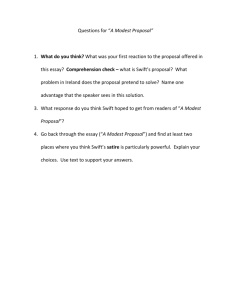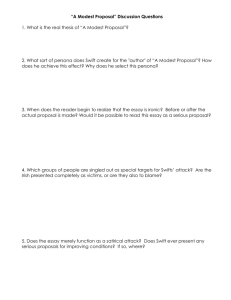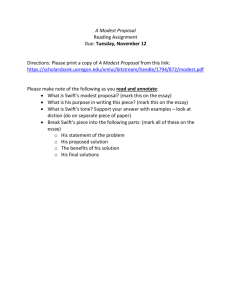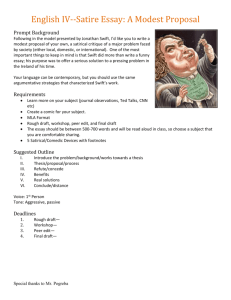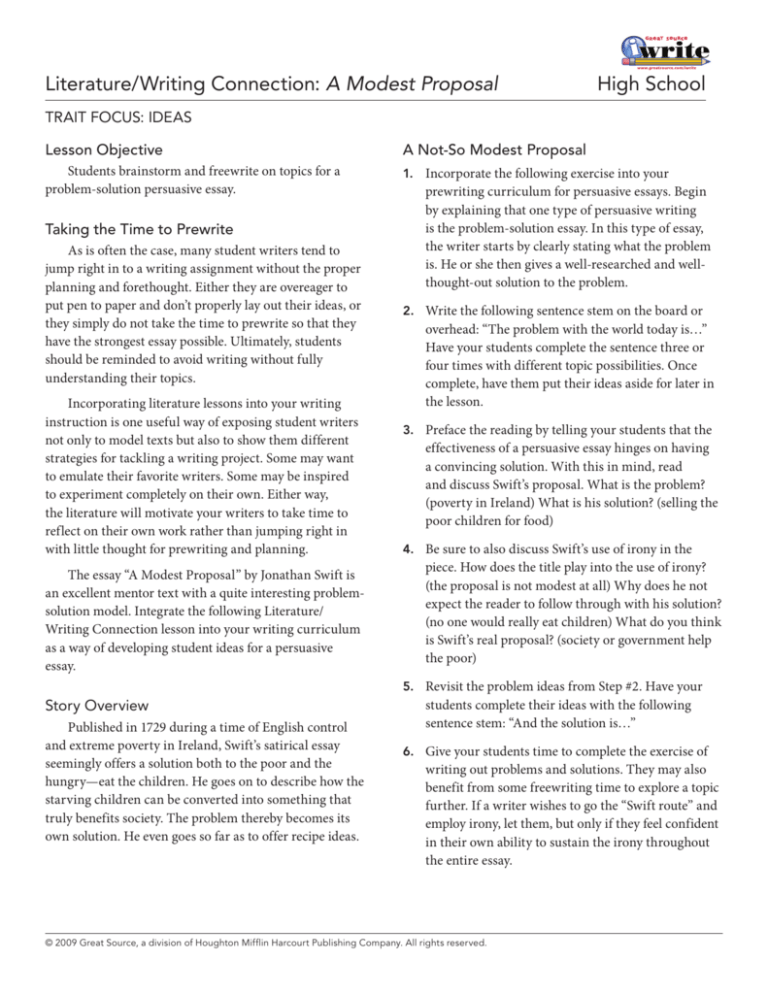
Literature/Writing Connection: A Modest Proposal
High School
Trait Focus: Ideas
Lesson Objective
A Not-So Modest Proposal
Students brainstorm and freewrite on topics for a
problem-solution persuasive essay.
1. Incorporate the following exercise into your
Taking the Time to Prewrite
As is often the case, many student writers tend to
jump right in to a writing assignment without the proper
planning and forethought. Either they are overeager to
put pen to paper and don’t properly lay out their ideas, or
they simply do not take the time to prewrite so that they
have the strongest essay possible. Ultimately, students
should be reminded to avoid writing without fully
understanding their topics.
Incorporating literature lessons into your writing
instruction is one useful way of exposing student writers
not only to model texts but also to show them different
strategies for tackling a writing project. Some may want
to emulate their favorite writers. Some may be inspired
to experiment completely on their own. Either way,
the literature will motivate your writers to take time to
reflect on their own work rather than jumping right in
with little thought for prewriting and planning.
The essay “A Modest Proposal” by Jonathan Swift is
an excellent mentor text with a quite interesting problemsolution model. Integrate the following Literature/
Writing Connection lesson into your writing curriculum
as a way of developing student ideas for a persuasive
essay.
prewriting curriculum for persuasive essays. Begin
by explaining that one type of persuasive writing
is the problem-solution essay. In this type of essay,
the writer starts by clearly stating what the problem
is. He or she then gives a well-researched and wellthought-out solution to the problem.
2. Write the following sentence stem on the board or
overhead: “The problem with the world today is…”
Have your students complete the sentence three or
four times with different topic possibilities. Once
complete, have them put their ideas aside for later in
the lesson.
3. Preface the reading by telling your students that the
effectiveness of a persuasive essay hinges on having
a convincing solution. With this in mind, read
and discuss Swift’s proposal. What is the problem?
(poverty in Ireland) What is his solution? (selling the
poor children for food)
4. Be sure to also discuss Swift’s use of irony in the
piece. How does the title play into the use of irony?
(the proposal is not modest at all) Why does he not
expect the reader to follow through with his solution?
(no one would really eat children) What do you think
is Swift’s real proposal? (society or government help
the poor)
5. Revisit the problem ideas from Step #2. Have your
Story Overview
Published in 1729 during a time of English control
and extreme poverty in Ireland, Swift’s satirical essay
seemingly offers a solution both to the poor and the
hungry—eat the children. He goes on to describe how the
starving children can be converted into something that
truly benefits society. The problem thereby becomes its
own solution. He even goes so far as to offer recipe ideas.
students complete their ideas with the following
sentence stem: “And the solution is…”
6. Give your students time to complete the exercise of
writing out problems and solutions. They may also
benefit from some freewriting time to explore a topic
further. If a writer wishes to go the “Swift route” and
employ irony, let them, but only if they feel confident
in their own ability to sustain the irony throughout
the entire essay.
© 2009 Great Source, a division of Houghton Mifflin Harcourt Publishing Company. All rights reserved.

